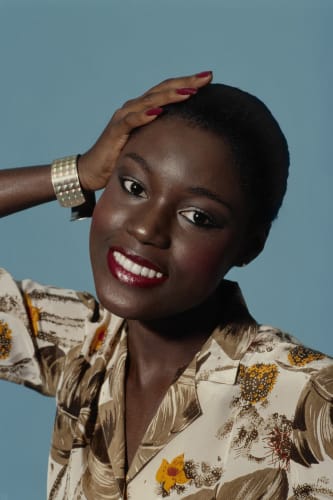Citing the luminaries captured through the lens of Kwame Brathwaite’s cameras, are, so to speak, mere snapshots of his remarkably productive career chronicling Americana, particularly Black life and culture. His images, photographed over seven decades, are a veritable encyclopedia of music, fashion, artistic and political organizations at home and abroad. Brathwaite, 85, made his transition peacefully in his sleep on April 1, according to a family statement.
Born Gilbert Ronald Brathwaite in Brooklyn on Jan. 1, 1938, he was the middle child of Cecil Brathwaite and Margaret Etelka Brathwaite that included his siblings Elombe Brath (1936-2014) and John Brathwaite (1943–). Key to his future in photography was his attendance at the School of Industrial Arts, now the High School of Art and Design, where he studied advertising arts. He graduated in 1955.
Inspired in part by the writings of Marcus Garvey and the teachings of Carlos Cooks, Brathwaite’s photography created the visual overture for the “Black is Beautiful Movement” in the early ’60s and ’70s. He energetically spread this idea through his writings and photographs, as well as the activities of the two organizations he helped co-found: AJASS (1956) and the Grandassa Models (1962).
In the late 1950s Brathwaite and AJASS became active in the African Nationalist Pioneer Movement (ANPM) led by Carlos Cooks. They were also involved in the early struggle for liberation in Southern Africa. Eleven years later they formed the Bronx-based South-West Africa Relief Committee to support Sam Nujoma’s South-West Africa People’s Organization (SWAPO) [and later, the People’s Liberation Army of Namibia (PLAN)]. Parallel to these political activities, AJASS was regularly producing concerts at such venues as Club 845 in the Bronx and Small’s Paradise in Harlem. Brathwaite took on the role of photographing and promoting these concerts which included cultural activities, poetry, theater, marketplaces and African dance performances.
Throughout the ’60s Brathwaite produced articles and pictorials for leading publications such as the Amsterdam News, Blues & Soul, City Sun and The Daily Challenge. By the 1970s, Brathwaite was one of the top music and cultural photographers, shaping the images of such public figures as Stevie Wonder, Bob Marley, James Brown and Muhammad Ali. Brathwaite wrote about and photographed such landmark events as the “The Motown Revue” at the Apollo (1963); “WattStax ’72” (1972); The Jackson 5’s first trip to Senegal, West Africa (1974); the “Festival in Zaire” (1974) which accompanied the famous Foreman-Ali fight, “The Rumble in the Jungle” as well as the inaugurations of Presidents Sam Nujoma in Namibia (1990) and Nelson Mandela in South Africa (1994).
Most recently, he was the subject of a major touring exhibition, “Kwame Brathwaite: Black Is Beautiful.” The exhibition traveled to eight cities in the United States: the Skirball Cultural Center (Los Angeles, CA); the Museum of the African Diaspora (San Francisco, CA); Columbia Museum of Art (Columbia, SC); Blanton Museum of Art (Austin, TX); Detroit Institute of Arts (Detroit, MI); Reynolds House, (Durham, NC); New York Historical Society (New York, NY) and Abrams-Engel Institute for the Visual Arts (Birmingham, AL). A monograph of the same title, produced by the Aperture Foundation, released May 2019, is in its fifth printing and features essays by Deborah Willis, professor and chair of the Department of Photography and Imaging at Tisch School of the Arts of New York University and Tanisha C. Ford, professor of history at The Graduate Center, CUNY. Brathwaite’s work is featured in the touring exhibition, “Black American Portraits,” which opened at the Los Angeles County Museum of Art, (Los Angeles, CA); and is currently at Spelman College Museum of Art (Atlanta, GA); and will travel to Memphis Brooks Museum of Art (Memphis, TN).
Brathwaite’s work recently appeared in “It’s Time” at Vielmetter (Los Angeles, CA), “Pocket Universe” at Philip Martin Gallery (Los Angeles, CA), “This Tender, Fragile Thing” at Jack Shainman Gallery (Kinderhook, NY). A short list of the venues presenting his work would exhaust the space allocated here, but we should note that the Studio Museum is among a number of institutions from California to Massachusetts, including the Smithsonian Museum, in which many of his works have been purchased. Private and corporate collections include JPMorgan Chase Art Collection (New York, NY), O’Melveny (Los Angeles, CA), Sidley Austin LLP (New York, NY), UBS Art Collection, UTA, and The Dean Collection among others. Brathwaite’s work has recently appeared in The New Yorker, The New York Times, Vogue, New York Post, New York Magazine, National Geographic, Aperture, and other publications.
Endowed with a tireless and expansive curiosity, Brathwaite began documenting jazz, but soon embarked on ventures that took him around the globe. But the travels always brought him back to Harlem. From his work at the Apollo Theater and numerous photographs of celebrities, to his fine art, fashion and political documentation, he was always about expanding our minds and showing how great Black culture is and always will be. Ambassador Neville Gertze, Permanent Representative of Namibia, writes of Kwame’s impact: “Through the lens of his camera and through his lifelong dedication to the Pan Africanism movement, Kwame leaves us with a rich legacy of a man who was uncompromised in spirit and in his support to the Civil Rights Movement, the struggles against Apartheid colonialism, inequality and injustice.”
Brathwaite retired in 2018 and is preceded in death by his parents and older brothers Keith Campbell and Elombe Brath. He is survived by his wife Sikolo Brathwaite, brother John Brathwaite, children Ndola Carlest and Kwame Samori Brathwaite and grandchildren Amina, Jackson, Carter and Kennedy along with nieces, nephews, family, friends and a community of cultural activists and creatives.
To learn more about Kwame Brathwaite and the Kwame Brathwaite Archive, go to https://kwamebrathwaite.com/archive/ or follow @ kwamebphoto on Instagram.

